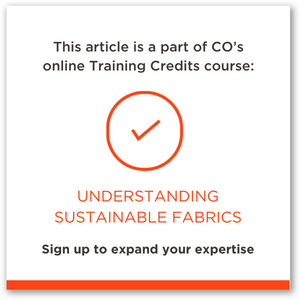With a heritage stretching back to 10,000 BC, wool is a fibre that has withstood the tests of time and fashion. Naturally hard-wearing and long-lasting, wool comes from sheep farmed across the world. Although only a fraction of garments now use wool, its thermal qualities are still highly valued.
Sheep fleece is the raw source for wool. In conventional farming, the sheep are ‘dipped’ in insecticides and fungicides to keep them healthy, and then shorn of their fleece once a year. The fleece is then cleaned and scoured to remove dirt and other impurities (including chemicals from dipping). Scouring also aligns the microscopic barbs in the fleece to give it a smoother feel.
The next stage is ‘carding’ whereby the fleece passes through a series of metal teeth to untangle and straighten the fibres. Depending on the yarn required, the fibres are then combed to remove the shorter lengths and to straighten them further.
Wool can be woven and knitted and blends well. It can absorb almost 30 per cent of its own weight in water, making it great for temperature regulation. Wool is still used for a range of clothing from formal suiting to casual knitwear.

Once golden fleeces
Sheep and wool were major sources of revenue in medieval times, becoming vital to the economies of Spain and England from the 1400s to the 1700s. The Industrial Revolution made further fortunes (and intensified worker exploitation) as mechanised mills spun and wove wool in such vast quantities that fleece needed to be imported from Australia and New Zealand.¹
The wool trade remained vibrant until around the 1960s when cheaper imports from Asia began to appear, synthetic fibres started to emerge and formal menswear went into decline. Now only around 1 per cent of all fibres used in garment production are wool.²
By the most recent available figures, the wool industry produces around 1.155 million kilograms (kg) of clean raw wool per year from a global herd of around 1.177 billion sheep.³ Each sheep yields about 4.5kg of wool per year – enough to produce 10 metres of fabric or about six jumpers (sweaters).⁴ These figures include wool textiles used for items other than garments – for example furniture or carpets.
If each sheep produces enough wool for six sweaters per year, the global wool herd of 1.177 billion sheep would, on average, produce enough fibre for 7 billion sweaters – just under one sweater per person per year for the entire global population.
Major wool producers are China, Australia and New Zealand with the UK, Iran, Russia and South Africa having sizeable production. Australia is the biggest exporter of wool, and China the largest importer.
Recycling vs. negative impacts
Land use, water pollution and global warming are all negative factors associated with wool production.
The Made-By Environmental Benchmark for Fibres ranks wool as Class E along with conventional cotton and virgin nylon.⁵ The Sustainable Apparel Coalition’s Higg Materials Sustainability Index ranks wool’s impact at 81 out of 300, compared to 99 for cotton, but much higher than polyester at 41.⁶
However both benchmarks only measure the impact up to the production of yarn or fabric and don’t take into consideration the full lifecycle of the product. As wool is a higher value and longer-wearing fibre, wool products are likely to stay in use longer, be washed less, recycled more and biodegrade at the end of their life.
According to the International Wool Textile Organisation (IWTO), up to 5 per cent by weight of the total clothing donated by consumers for recycling and re-use is wool. The IWTO has a technical advisory group working on ensuring more robust lifecycle assessments for wool.⁷
Calculations around the land use required by wool have also been challenged. The 1.16 billion sheep are also part of the food industry and often raised on land that cannot be used for arable food crops.
Animal welfare is a key issue for wool production. The Responsible Wool Standard (RWS) from Textile Exchange is a voluntary global standard that addresses the welfare of sheep and the land they graze on. The standard also follows the chain of custody from farm to final product, so consumers can have confidence in the RWS logo.
The Global Organic Textile Standard (GOTS) also applies to wool. As with all GOTS certification it covers the processing of the fibre, not its production, which is covered by government organic standards.
| Mulesing:
Mulesing involves the removal of sections of skin around the breech (buttocks) of a sheep to reduce the incidence of flystrike. Flystrike is a condition where flies lay eggs in the folds of skin and as they hatch burrow into the flesh.
Flystrike can be controlled by regular ‘crutching’ (removal of wool from the area) and inspection. Such hands-on husbandry can be costly for large farms, as in Australia where mulesing is most prevalent. Many years of lobbying have prompted the Australian wool industry to promise to phase out mulesing which is still legal.
|
Other organisations run voluntary initiatives to improve welfare and traceability:
ZQ Merino: from New Zealand Merino for fully traceable, non-mulsed, merino wool.
The Dumfries Declaration: Signatories to the Dumfries Declaration commit their company to abide by ten principles of best practice for the wool industry.
IWTO Specifications for Wool Sheep Welfare: developed by the wool growing country members of IWTO.
References
1. International Wool Textile Organisation (2017) Wool Industry
2. Textile Exchange Preferred Fiber and Materials Market Report 2021
3. International Wool Textile Organisation (2018) Wool Supply Chain
4. FAOSTAT (2017) Wool Statistics
5. Good On You (2020) Made-By Environmental Benchmark for Fibres
6. Apparel Insider (2018) Higg Materials Sustainability Index updated
7. IWTO (2020) Recycled Wool
